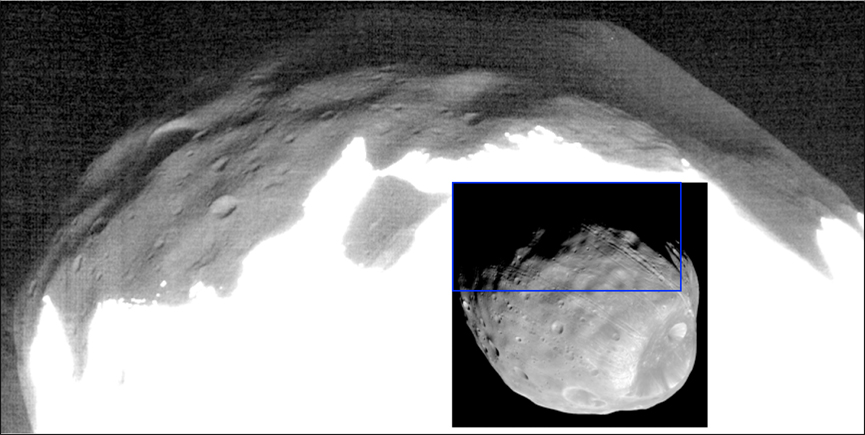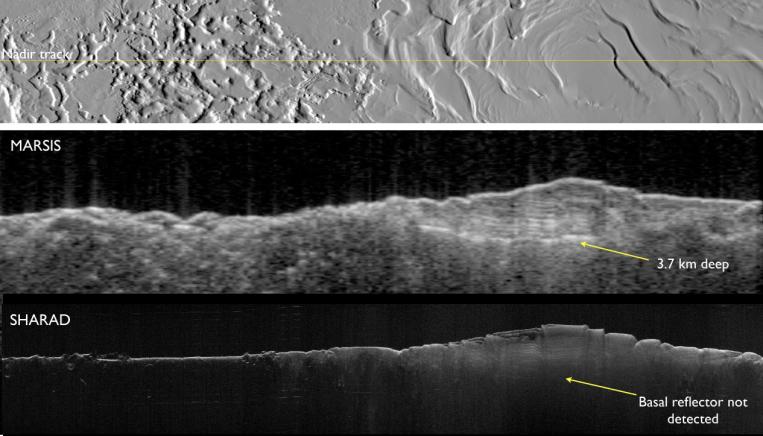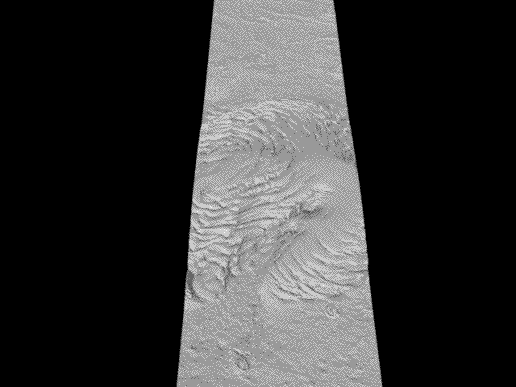New Mars Forums
You are not logged in.
- Topics: Active | Unanswered
Announcement
#126 2008-04-17 16:10:42
- 3488
- Member
- From: Ashford, Kent, United Kingdom
- Registered: 2008-04-15
- Posts: 23
Re: Mars Reconnaissance Orbiter (MRO)
Absolutely Commodore. I suggested HiRISE Phobos & Deimos observations in the HiRISE HiBlog & email a while back. I know that I was not alone, but a good case was made.
I have also suggested that the observations be repeated when Mars is at a different point in its Heliocentric orbit, so the illumination is at a differnet angle (obviously not when Phobos is at New Phase as pointing HiRISE in the direction of the Sun would be very stupid & foolish).
Perhaps these observations will help determine the origin of Phobos & Deimos. I still recko they are captured type D asteroids, more typical of the asteroids in the outer part of the Asteroid Belt.
Also maybe very similar to some of Jupiter's outermost moons in the retrograde family like Pasiphae, Sinope, Carme, Anake, Erinome, etc?
I hope HiRISE does get to do Deimos too.
MRO HiRISE of Phobos.
MRO HiRISE of the Marsshine on the night side of Phobos.
Andrew Brown.
"I suddenly noticed an anomaly to the left of Io, just off the rim of that world. It was extremely large with respect to the overall size of Io". Linda Morabito on discovering that the Jupiter moon Io was volcanically active. Friday 9th March 1979.
Offline
Like button can go here
#127 2008-04-17 16:25:57
- RedStreak
- Banned
- From: Illinois
- Registered: 2006-05-12
- Posts: 541
Re: Mars Reconnaissance Orbiter (MRO)
Perhaps these observations will help determine the origin of Phobos & Deimos. I still recko they are captured type D asteroids, more typical of the asteroids in the outer part of the Asteroid Belt.
Also maybe very similar to some of Jupiter's outermost moons in the retrograde family like Pasiphae, Sinope, Carme, Anake, Erinome, etc?
Considering the 'small' quirks of Phobos & Deminos I think there has to be a little more to their origins. The capture theory works easily for those aforementioned Jovian moons and the eccentricity & out-of-aligment arrangements even scream it. Problem is...has anyone noticed both Phobos and Deimos are in circular orbits? More suprising still circular orbits well-aligned with the Martian equator.
I read in an Astronomy article how it can also be noted, when the clock is rewound, both moons also reach a shared orbit...and considering the huge WHAM Phobos received from its Stickney crater it isn't hard picturing a large source asteroid getting shattered with its fragments becoming the moons we know today.
Although not as extreme as Earth's moon in origin, by the same token Phobos and Deimos might have primordial Martian material mixed in them or Martian material blown off Mars might often land on them - heck one argument for returning to the moon is finding Earth rocks there! ![]()
Anyone else take note of this with the Martian moons?
Offline
Like button can go here
#128 2008-04-17 16:58:29
- 3488
- Member
- From: Ashford, Kent, United Kingdom
- Registered: 2008-04-15
- Posts: 23
Re: Mars Reconnaissance Orbiter (MRO)
"Commodore wrote:Perhaps these observations will help determine the origin of Phobos & Deimos. I still reckon they are captured type D asteroids, more typical of the asteroids in the outer part of the Asteroid Belt.
Also maybe very similar to some of Jupiter's outermost moons in the retrograde family like Pasiphae, Sinope, Carme, Ananke, Erinome, etc?
Considering the 'small' quirks of Phobos & Deminos I think there has to be a little more to their origins. The capture theory works easily for those aforementioned Jovian moons and the eccentricity & out-of-aligment arrangements even scream it. Problem is...has anyone noticed both Phobos and Deimos are in circular orbits? More suprising still circular orbits well-aligned with the Martian equator.
I read in an Astronomy article how it can also be noted, when the clock is rewound, both moons also reach a shared orbit...and considering the huge WHAM Phobos received from its Stickney crater it isn't hard picturing a large source asteroid getting shattered with its fragments becoming the moons we know today.
Although not as extreme as Earth's moon in origin, by the same token Phobos and Deimos might have primordial Martian material mixed in them or Martian material blown off Mars might often land on them - heck one argument for returning to the moon is finding Earth rocks there!

Anyone else take note of this with the Martian moons?
Cheers RedStreak. Yes I see that. I am not sure that Phobos & Deimos were ever part of the same body, though they probably originated from a similar area.
The fact that both Phobos & Deimos have spectra very similar to some of Jupiter's outermost moons & many asteroids in the outer part of the Asteroid Belt, does seem to scream to me that they have more in common with them than with Mars or the inner solar system generally.
One problem I see, is that Phobos & Deimos being carbonaceous, possibly even somewhat hydrated, suggests to me that they formed outside of the frost line approx 2.7 AU, during the Sun's youth (when the Sun was 30% less powerful than now). I could be wrong, but I do not think either Phobos or Deimos formed anywhere near Mars.
However, they almost certainly have ancient Martian rocks on the surfaces.
Good point about returning to the Moon, regarding ancient Earth rocks. Another good reason to go back, is to get very deep core samples of the regolith, to obtain data of early Sun activity & perhaps clues as the the environments the Solar System passes through as it completes each 225 million year long orbit around the Milky Way's centre.
Perhaps there is evidence locked away of nearby supernovae, passages through nebulae, close encounters with powerful stars, etc?
Perhaps Phobos & Deimos also hold clues to this?
Andrew Brown.
"I suddenly noticed an anomaly to the left of Io, just off the rim of that world. It was extremely large with respect to the overall size of Io". Linda Morabito on discovering that the Jupiter moon Io was volcanically active. Friday 9th March 1979.
Offline
Like button can go here
#129 2008-04-18 13:26:58
- 3488
- Member
- From: Ashford, Kent, United Kingdom
- Registered: 2008-04-15
- Posts: 23
Re: Mars Reconnaissance Orbiter (MRO)
MRO SHARAD penetrates Martian South Polar Cap.
Comparisons between MRO SHARAD & MEX MARSIS, revealing how the two complement each other, MEX Marsis was able to penetrate very deep, approx 3,700 metres, where as MRO SHARAD shows a higher resolution in the structure nearer the surface.
Animation.
Andrew Brown.
"I suddenly noticed an anomaly to the left of Io, just off the rim of that world. It was extremely large with respect to the overall size of Io". Linda Morabito on discovering that the Jupiter moon Io was volcanically active. Friday 9th March 1979.
Offline
Like button can go here
#130 2020-01-20 17:34:47
- SpaceNut
- Administrator
- From: New Hampshire
- Registered: 2004-07-22
- Posts: 29,913
Re: Mars Reconnaissance Orbiter (MRO)
What no news since the great crash wow...
NASA watched the ice in this Mars crater dance over a dozen years
NASA's Mars Reconnaissance Orbiter captures a beautiful view of a shifting Martian landscape over time.
HiRise (High Resolution Imaging Science Experiment) camera team at the University of Arizona.
https://www.uahirise.org/ESP_062793_2655
NASA GIF of a north-pole crater shows.
The GIF is compiled from MRO images taken over the span of nearly a dozen years in early 2008, 2010, 2012, 2016, 2018 and late 2019. That spans six Mars Years. Each Mars Year covers 687 Earth days.
MRO entered Martian orbit in 2006.
Offline
Like button can go here
#131 2022-01-22 21:26:35
- SpaceNut
- Administrator
- From: New Hampshire
- Registered: 2004-07-22
- Posts: 29,913
Re: Mars Reconnaissance Orbiter (MRO)
Bouncing Boulders Point to Quakes on Mars
Seen from orbit the path that rocks which have moved can be seen.
The imagery was captured from 2006 through 2020 by the High Resolution Imaging Science Experiment (HiRISE) camera onboard NASA’s Mars Reconnaissance Orbiter and revealed details as small as 10 inches across.
Vijayan and his collaborators spotted more than 4,500 such boulder tracks, the longest of which stretched more than a mile and a half.
Offline
Like button can go here
#132 2022-03-18 07:07:54
- Mars_B4_Moon
- Member
- Registered: 2006-03-23
- Posts: 9,776
Re: Mars Reconnaissance Orbiter (MRO)
Stunning 8K photos of Mars provide insight into its past
https://www.tweaktown.com/news/85107/st … index.html
Last edited by Mars_B4_Moon (2022-03-18 07:10:38)
Offline
Like button can go here
#133 2022-11-27 20:01:21
- SpaceNut
- Administrator
- From: New Hampshire
- Registered: 2004-07-22
- Posts: 29,913
Re: Mars Reconnaissance Orbiter (MRO)
Mars has burped again, and a cloud can be seen from orbit.
Offline
Like button can go here
#134 2023-03-18 18:51:17
- SpaceNut
- Administrator
- From: New Hampshire
- Registered: 2004-07-22
- Posts: 29,913
Re: Mars Reconnaissance Orbiter (MRO)
Good question How much fuel is left in this 20-year-old Mars orbiter?
The longer a mission can keep running, the more data it can collect, and the more we can learn from it.
That’s true for the orbiters which travel around Mars as well as the rovers which explore its surface, like the Mars Odyssey spacecraft which was launched in 2001 and has been in orbit around Mars for more than 20 years. But the orbiter can’t keep going forever as it will eventually run out of fuel, so figuring out exactly how much fuel is left is important — but it also turned out to be more complicated than the NASA engineers were expecting.
Odyssey started out with nearly 500 pounds of hydrazine fuel, though last year it looked as if the spacecraft was running much lower on fuel than had been predicted.
There is no gas gage, so they are making in direct measured to solve too how much.
Offline
Like button can go here